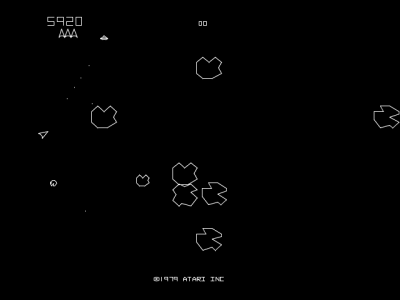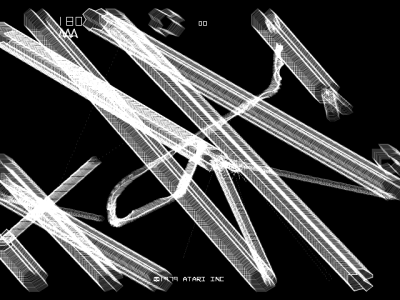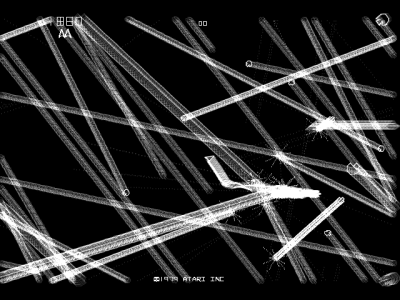Asteroids: Forgotten Futurism
Game informationDeveloper: Atari Publisher: Atari Released: 1979
Screenshots
ReviewI am in front of an arcade game, and I am a small spaceship on the screen. To move forward, I must think of forward as the direction that my spaceship-me is pointing on the screen. The forward of my spaceship-me is sometimes up, sometimes down, sometimes other directions. When I first played games like this, it was hard to map the presence of the spaceship onto my bodily presence and actions in front of the arcade cabinet. It is an acquired taste. Asteroids emits an air of forgotten futurism, of roads not taken. The game uses a vector display: not the usual grid of pixels, but a beam that traces the outlines of the game elements. The player's shots burn through the screen, presumably outlined by the beam several times each update. Vector graphics were Atari's signature for a while: Lunar Lander (1979), Battlezone (1980), Tempest (1980), Space Duel (1982) and Star Wars (1983). Had I been a science fiction writer in the 1950s, these are the games my characters would be playing in the distant future – military, scientific, platonic. Asteroids is almost a good game. There is a focused core activity, shooting rocks, which makes the rocks break into smaller and faster pieces. This changes the layout of each level, changes the strategy and feel from the beginning to the end of a level, and renders the game varied enough to just work. The occasionally appearing UFO is the final ingredient, giving the world just one object with intentions, and alleviating the loneliness of the universe: I am not alone with these vacuous rocks after all; there is an opponent that cares about me. Asteroids fails: there is not enough variation in the tasks I have to perform; the screen is oddly empty. I fly around and shoot, but everything melts into air; I can make no marks on the world. There are only rudimentary strategies for me to create. The edge of the screen is muddy and unsatisfying. There is no progress. Asteroids is a nostalgic game of the future, but the actual future has better games.
|


